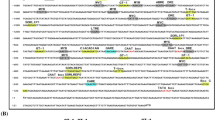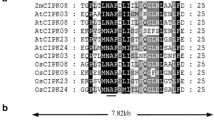Abstract
In our previous research, we showed that the cyclin-dependent kinase regulatory subunit (CKS2) in maize (Zea mays L.) was induced by water deficit and cold stress. To elucidate its expression patterns under adversity, we isolated and characterized its promoter (PZmCKS2). A series of PZmCKS2-deletion derivatives, P0–P3, from the translation start code (−1,455, −999, −367, and −3 bp) was fused to the β-glucuronidase (GUS) reporter gene, and each deletion construct was analyzed by Agrobacterium-mediated steady transformation into Arabidopsis. Leaves were then subjected to dehydration, cold, abscisic acid (ABA), salicylic acid (SA), and methyl jasmonic acid (MeJA). Sequence analysis showed that several stress-related cis-acting elements (MBS, CE3, TGA element, and ABRE) were located within the promoter. Deletion analysis of the promoter, PZmCKS2, suggested that the −999 bp promoter region was required for the highest basal expression of GUS, and the −367 bp sequence was the minimal promoter for ZmCKS2 activation by low temperature, ABA, and MeJA. The cis-acting element ABRE was necessary for promoter activation by exogenous ABA.







Similar content being viewed by others
Abbreviations
- 4-MU:
-
4-Methylumbelliferone
- ABRE:
-
Abscisic acid-responsive element
- CRT/DRE:
-
C-repeat/dehydration-responsive element
- CDK:
-
Cyclin-dependent kinases
- CE3:
-
Coupling element
- CKS:
-
Cyclin-dependent kinase unit
- GUS:
-
Glucuronidase
- MeJA:
-
Methyl jasmonic acid
- MS:
-
Murashige and Skoog medium
- PEG:
-
Polyethylene glycol
- SA:
-
Salicylic acid
- ABA:
-
Abscisic acid
References
Benfey PN, Ren L, Chua N-H (1989) The CaMV 35S enhancer contains at least two domains which can confer different developmental and tissue-specific expression patterns. EMBO J 8(8):2195
Bousquet J, Simon L, Lalonde M (1990) DNA amplification from vegetative and sexual tissues of trees using polymerase chain reaction. Can J Forest Res 20(2):254–257
Busk PK, Pages M (1998) Regulation of abscisic acid-induced transcription. Plant Mol Biol 37(3):425–435
Chen H, Nelson R, Sherwood J (1994) Enhanced recovery of transformants of Agrobacterium tumefaciens after freeze-thaw transformation and drug selection. Biotechniques 16(4):664–668 (670)
Clough SJ, Bent AF (1998) Floral dip: a simplified method for Agrobacterium-mediated transformation of Agrobacterium thaliana. Plant J 16(6):735–743
Dalal M, Chinnusamy V, Bansal KC (2010) Isolation and functional characterization of lycopene β-cyclase (CYC-B) promoter from Solanum habrochaites. BMC Plant Biol 10(1):61
De Veylder L, Beemster GT, Beeckman T, Inzé D (2001) Cks1at overexpression in Arabidopsis thaliana inhibits growth by reducing meristem size and inhibiting cell-cycle progression. Plant J 25(6):617–626
Doonan JH, Kitsios G (2009) Functional evolution of cyclin-dependent kinases. Mol Biotechnol 42(1):14–29
Dubos C, Stracke R, Grotewold E, Weisshaar B, Martin C, Lepiniec L (2010) MYB transcription factors in Arabidopsis. Trends Plant Sci 15(10):573–581
Dunn MA, White AJ, Vural S, Hughes MA (1998) Identification of promoter elements in a low-temperature-responsive gene (blt4.9) from barley (Hordeum Vulgare L.). Plant Mol Biol 38(4):551–564
Durner J, Shah J, Klessig DF (1997) Salicylic acid and disease resistance in plants. Trends Plant Sci 2(7):266–274
Egan EA, Solomon MJ (1998) Cyclin-stimulated binding of CKS proteins to cyclin-dependent kinases. Mol Cell Biol 18(7):3659–3667
Eulgem T, Somssich IE (2007) Networks of WRKY transcription factors in defense signaling. Curr Opin Plant Biol 10(4):366–371
Giuliano G, Pichersky E, Malik V, Timko M, Scolnik P, Cashmore A (1988) An evolutionarily conserved protein binding sequence upstream of a plant light-regulated gene. P Natl Acad Sci USA 85(19):7089–7093
Haake V, Cook D, Riechmann J, Pineda O, Thomashow MF, Zhang JZ (2002) Transcription factor CBF4 is a regulator of drought adaptation in Arabidopsis. Plant Physiol 130(2):639–648
Hadwiger J, Wittenberg C, Mendenhall M, Reed S (1989) The saccharomyces cerevisiae cks1 gene, a homolog of the schizosaccharomyces pombe suc1+ gene, encodes a subunit of the cdc28 protein kinase complex. Mol Cell Biol 9(5):2034–2041
Harper JW (2001) Protein destruction: adapting roles for cks proteins. Curr Biol 11(11):R431–R435
Hayles J, Aves S, Nurse P (1986) Suc1 is an essential gene involved in both the cell cycle and growth in fission yeast. EMBO J 5(12):3373
Hobo T, Asada M, Kowyama Y, Hattori T (1999a) ACGT-containing abscisic acid response element (ABRE) and coupling element 3 (CE3) are functionally equivalent. Plant J 19(6):679–689
Hobo T, Kowyama Y, Hattori T (1999b) A bzip factor, TRAB1, interacts with VP1 and mediates abscisic acid-induced transcription. P Natl Acad Sci USA 96(26):15348–15353
Hoeren FU, Dolferus R, Wu Y, Peacock WJ, Dennis ES (1998) Evidence for a role for AtMYB2 in the induction of the Arabidopsis alcohol dehydrogenase gene (ADH1) by low oxygen. Genetics 149(2):479–490
Hwang JKHBK (2009) The promoter of the pepper pathogen-induced membrane protein gene CAPIMP1 mediates environmental stress responses in plants. Planta 229:249–259
Hwang S-H, Hwang D-J (2010) Isolation and characterization of the rice NPR1 promoter. Plant Biotechnol Reports 4(1):29–35
Hwang S-H, Lee IA, Yie SW, Hwang D-J (2008) Identification of an OsPR10a promoter region responsive to salicylic acid. Planta 227(5):1141–1150
Jefferson RA (1988) Plant reporter genes: the GUS gene fusion system. Genet Eng 10:247–263
Jiang C, Iu B, Singh J (1996) Requirement of a CCGAC cis-acting element for cold induction of the BN115 gene from winter brassica napus. Plant Mol Biol 30(3):679–684
Liberal V, Martinsson-Ahlzen H, Liberal J, Spruck C, Widschwendter M, McGowan C, Reed S (2011) Breast cancer special feature: cyclin-dependent kinase subunit (cks) 1 or cks2 overexpression overrides the DNA damage response barrier triggered by activated oncoproteins. P Natl Acad Sci USA 109(8):2754–2759
Liberal V, Martinsson-Ahlzén H-S, Liberal J, Spruck CH, Widschwendter M, McGowan CH, Reed SI (2012) Cyclin-dependent kinase subunit (cks) 1 or cks2 overexpression overrides the DNA damage response barrier triggered by activated oncoproteins. P Natl Acad Sci USA 109(8):2754–2759
Livak KJ, Schmittgen TD (2001) Analysis of relative gene expression data using real-time quantitative PCR and the 2−∆∆ct method. Methods 25(4):402–408
Loake GJ, Faktor O, Lamb CJ, Dixon RA (1992) Combination of H-box [CCTACC (N) 7CT] and G-box (CACGTG) cis elements is necessary for feed-forward stimulation of a chalcone synthase promoter by the phenylpropanoid-pathway intermediate p-coumaric acid. P Natl Acad Sci USA 89(19):9230–9234
Machens F, Becker M, Umrath F, Hehl R (2014) Identification of a novel type of WRKY transcription factor binding site in elicitor-responsive cis-sequences from Arabidopsis thaliana. Plant Mol Biol 84:371–385
Martinsson-Ahlzén H-S, Liberal V, Grünenfelder B, Chaves SR, Spruck CH, Reed SI (2008) Cyclin-dependent kinase-associated proteins cks1 and cks2 are essential during early embryogenesis and for cell cycle progression in somatic cells. Mol Cell Biol 28(18):5698–5709
McKendree WL Jr, Ferl RJ (1992) Functional elements of the arabidopsis ADH promoter include the G-box. Plant Mol Biol 19(5):859–862
Mehrotra R, Kiran K, Chaturvedi CP, Ansari SA, Lodhi N, Sawant S, Tuli R (2005) Effect of copy number and spacing of the acgt and GT cis elements on transient expression of minimal promoter in plants. J Genet 84(2):183
Rabbani MA, Maruyama K, Abe H, Khan MA, Katsura K, Ito Y, Yoshiwara K, Seki M, Shinozaki K, Yamaguchi-Shinozaki K (2003) Monitoring expression profiles of rice genes under cold, drought, and high-salinity stresses and abscisic acid application using cDNA microarray and RNA gel-blot analyses. Plant Physiol 133(4):1755–1767. Available from http://www.ncbi.nlm.nih.gov/pmc/articles/PMC300730/pdf/1331755.pdf
Reynard GJ, Reynolds W, Verma R, Deshaies RJ (2000) Cks1 is required for G1 cyclin–cyclin-dependent kinase activity in budding yeast. Mol Cell Biol 20(16):5858–5864
Rouster J, Leah R, Mundy J, Cameron-Mills V (1997) Identification of a methyl jasmonate-responsive region in the promoter of a lipoxygenase 1 gene expressed in barley grain. Plant J 11(3):513–523
Shah J, Klessig DF (1996) Identification of a salicylic acid-responsive element in the promoter of the tobacco pathogenesis related β-1, 3-glucanase gene, PR-2d. Plant J 10(6):1089–1101
Shen Q, Ho T (1995) Functional dissection of an abscisic acid (ABA)-inducible gene reveals two independent ABA-responsive complexes each containing a G-box and a novel cis-acting element. Plant Cell Online 7(3):295–307
Shen Q, Zhang P, Ho T (1996) Modular nature of abscisic acid (ABA) response complexes: composite promoter units that are necessary and sufficient for ABA induction of gene expression in barley. Plant Cell Online 8(7):1107–1119
Shinozaki K, Yamaguchi-Shinozaki K (2000) Molecular responses to dehydration and low temperature: differences and cross-talk between two stress signaling pathways. Curr Opin Plant Biol 3(3):217–223
Straub PF, Shen Q, T-Hd Ho (1994) Structure and promoter analysis of an ABA-and stress-regulated barley gene, HVA1. Plant Mol Biol 26(2):617–630
Sun C, Palmqvist S, Olsson H, Borén M, Ahlandsberg S, Jansson C (2003) A novel WRKY transcription factor, SUSIBA2, participates in sugar signaling in barley by binding to the sugar-responsive elements of the iso1 promoter. Plant Cell Online 15(9):2076–2092
Sun H, Huang X, Xu X, Lan H, Huang J, Zhang HS (2012) ENAC1, a NAC transcription factor, is an early and transient response regulator induced by abiotic stress in rice (oryza sativa L.). Mol Biotechnol 52:1–10
Villain P, Clabault G, Mache R, Zhou D-X (1994) S1f binding site is related to but different from the light-responsive gt-1 binding site and differentially represses the spinach rps1 promoter in transgenic tobacco. J Biol Chem 269(24):16626–16630
Villain P, Mache R, Zhou D-X (1996) The mechanism of GT element-mediated cell type-specific transcriptional control. J Biol Chem 271(51):32593–32598
Weisshaar B, Armstrong G, Block A, e Silva ODC, Hahlbrock K (1991) Light-inducible and constitutively expressed DNA-binding proteins recognizing a plant promoter element with functional relevance in light responsiveness. EMBO J 10(7):1777
Yamaguchi-Shinozaki K, Shinozaki K (1993) The plant hormone abscisic acid mediates the drought-induced expression but not the seed-specific expression of RD22, a gene responsive to dehydration stress in Aarabidopsis thaliana. Mol Gen Genet 238(1–2):17–25
Yamaguchi-Shinozaki K, Shinozaki K (1994) A novel cis-acting element in an Arabidopsis gene is involved in responsiveness to drought, low-temperature, or high-salt stress. Plant Cell Online 6(2):251–264. Available from http://www.ncbi.nlm.nih.gov/pmc/articles/PMC160431/pdf/060251.pdf
Zhou D-X (1999) Regulatory mechanism of plant gene transcription by GT-elements and GT-factors. Trends Plant Sci 4(6):210–214
Zhou J, Wang X, Jiao Y, Qin Y, Liu X, He K, Chen C, Ma L, Wang J, Xiong L (2007) Global genome expression analysis of rice in response to drought and high-salinity stresses in shoot, flag leaf, and panicle. Plant Mol Biol 63(5):591–608
Acknowledgments
This research was funded by the Twelfth Five Year Plan Project of Science and Technology Support, P. R. China (2012BAD19B04, 2014BAD14B02), the Ministry of Agriculture Key Project of GM Cultivation of New Varieties, P. R. China (2013ZX08004004), and the Research and Development of Industrial Technology Special at Jilin Provincial Development and Reform Commission (2013C001). We express our sincere appreciation to the anonymous reviewers for their insightful comments, which greatly aided us in improving the quality of the paper.
Author information
Authors and Affiliations
Corresponding author
Additional information
Communicated by M. Hajduch.
F. Wang and J. Liu equally contributed to this manuscript.
Rights and permissions
About this article
Cite this article
Wang, F., Liu, J., Li, J. et al. Functional analyses of the maize CKS2 gene promoter in response to abiotic stresses and hormones. Acta Physiol Plant 36, 1867–1878 (2014). https://doi.org/10.1007/s11738-014-1563-3
Received:
Revised:
Accepted:
Published:
Issue Date:
DOI: https://doi.org/10.1007/s11738-014-1563-3




